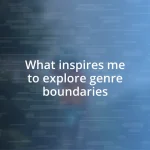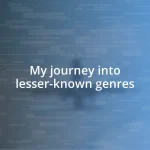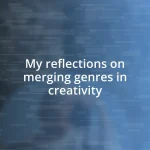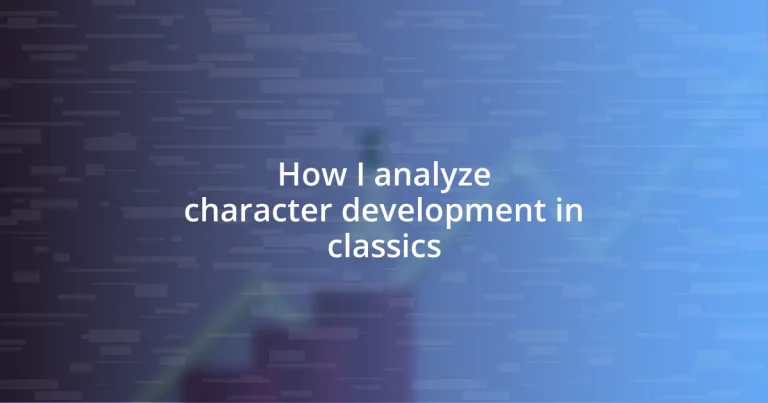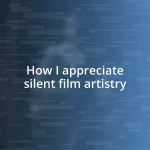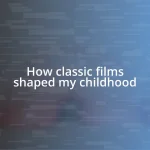Key takeaways:
- Character development enriches narratives, reflecting personal growth and relatable journeys, as seen in Elizabeth Bennet’s evolution and Gatsby’s disillusionment.
- Key traits and transformations in characters like Sydney Carton and Jane Eyre showcase how experiences foster resilience and moral clarity.
- The exploration of motivations and dynamics among characters, such as Lady Macbeth’s ambition and the bond between Sam and Frodo, reveals the depth of human relationships and internal conflicts.
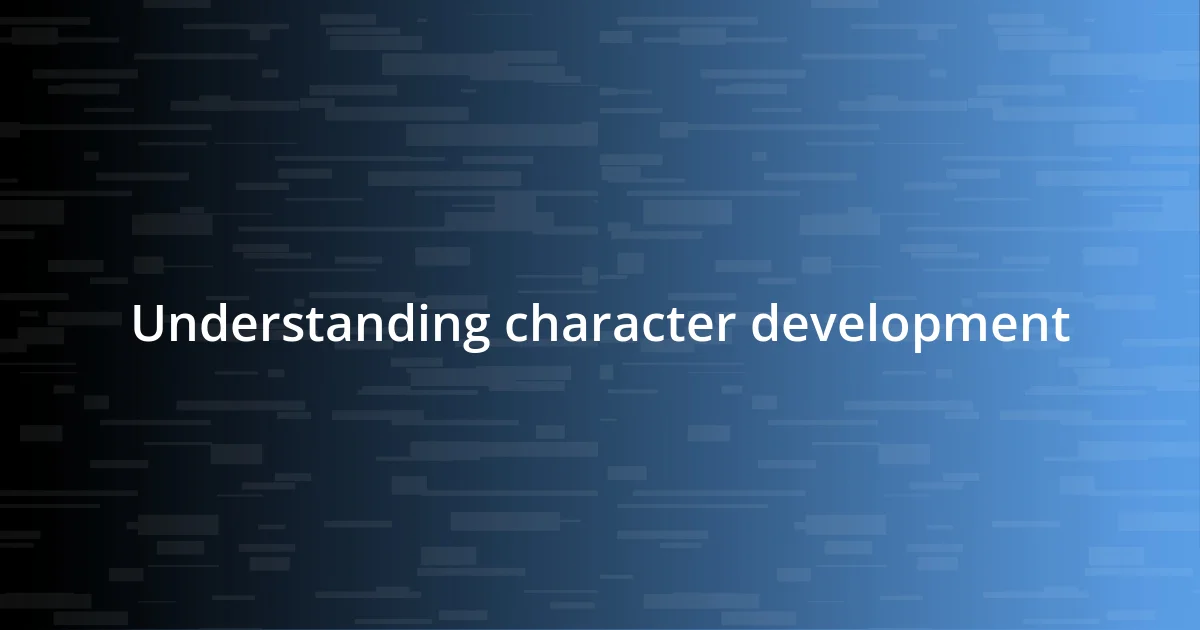
Understanding character development
Character development is essential in literature, as it transforms a flat figure into a vivid person with whom readers can connect. I recall reading “Pride and Prejudice” for the first time; Elizabeth Bennet’s evolution from prejudice to understanding struck me deeply. Isn’t it fascinating how her progression mirrors our own experiences in overcoming biases?
When analyzing characters, I often look for pivotal moments that catalyze change. For example, think about Jay Gatsby in “The Great Gatsby.” His relentless pursuit of an idealized past reveals much about the human condition—our unyielding hopes and disillusionments. Have you ever found yourself chasing something you later realized was unattainable?
Emotional depth in characters doesn’t just serve the narrative; it reflects the complexities of our own lives. I remember feeling utterly heartbroken as I witnessed the transformation of Anakin Skywalker into Darth Vader. That internal conflict sparked a realization for me: understanding character flaws makes their journeys all the more relatable, demonstrating that redemption and failure often coexist within us all.
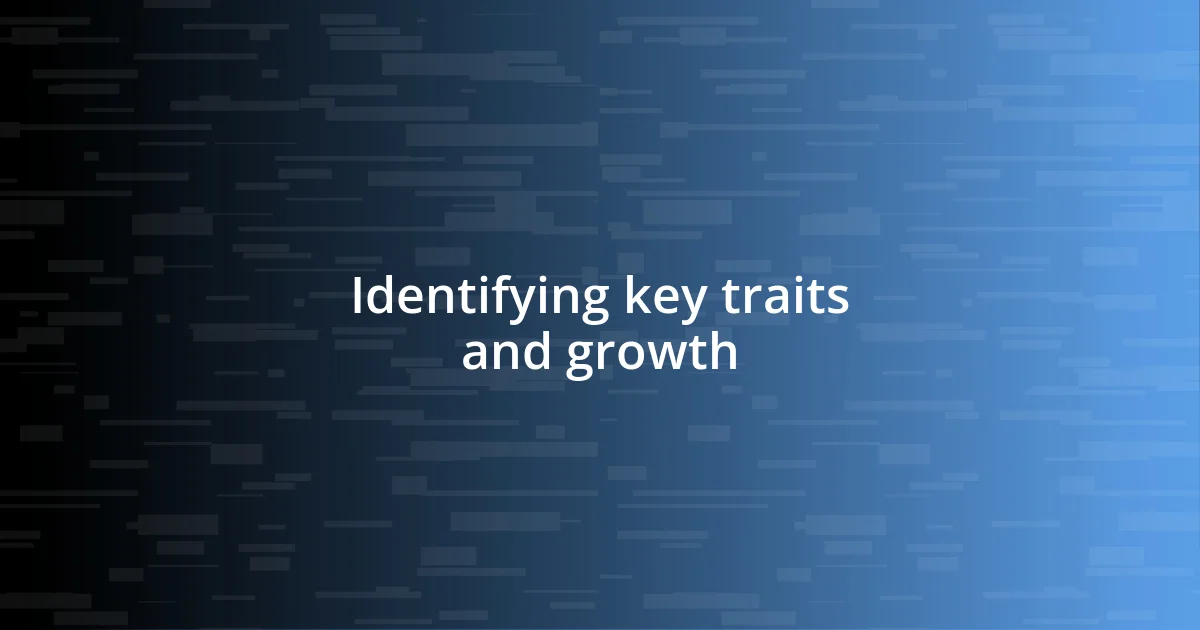
Identifying key traits and growth
Identifying key traits and growth in literary characters is something I genuinely enjoy exploring. Often, I focus on a character’s defining characteristics, such as their fears or motivations, to pinpoint the foundation of their growth. For instance, in “A Tale of Two Cities,” Sydney Carton’s initial apathy contrasts sharply with his ultimate sacrifice, illustrating profound personal transformation that resonates deeply with me.
When I examine growth, I pay attention to how these traits evolve through experiences. Take Jane Eyre, for example. Her strength in overcoming abandonment and hardship showcases her resilience and moral clarity. I remember during my first reading, feeling inspired by her determination; it serves as a reminder that growth often stems from facing our deepest fears and embracing our vulnerabilities.
I also find it valuable to map out the character’s journey, noting key turning points that lead to significant changes. The journey of Holden Caulfield from alienation to a search for connection in “The Catcher in the Rye” profoundly illustrates this. Reflecting on my younger years, I too felt lost at times, and his struggle to find his place resonated with my own experiences, emphasizing the universal nature of character growth.
| Character | Key Traits |
|---|---|
| Sydney Carton | Apathy, Sacrifice |
| Jane Eyre | Resilience, Moral Clarity |
| Holden Caulfield | Alienation, Search for Connection |
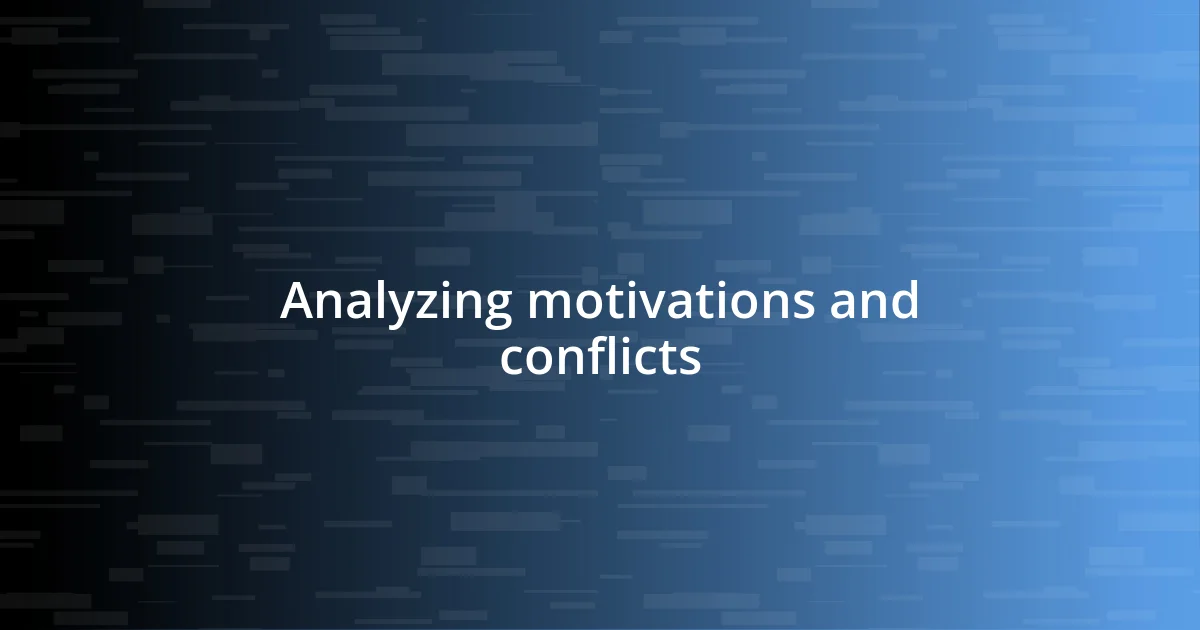
Analyzing motivations and conflicts
When I dig into motivations and conflicts, I often reflect on what compels characters to act. Take Lady Macbeth from “Macbeth,” for example. Her relentless ambition sets off a chain reaction of moral decay. It’s intriguing how her desire for power leads to her ultimate unraveling, illustrating that our deepest desires can sometimes become our own worst enemies. I have often thought about how my ambitions shape my decisions and, at times, even cloud my judgment.
To deepen my analysis, I also consider the external and internal conflicts characters face. This can dramatically influence their motivations, making them more relatable. Here are some conflict themes I look for:
- Internal Conflict: Characters wrestling with their own morals, like Hamlet, who struggles with indecision.
- External Conflict: Pressure from society, as seen in “The Crucible,” where characters grapple with societal expectations and fears.
- Moral Dilemmas: Decisions that provoke guilt or fear, such as Elizabeth Bennet facing societal norms in “Pride and Prejudice.”
These layered motivations help me unravel the complexity within characters, reminding me of my own journey through moments of doubt and conflict.
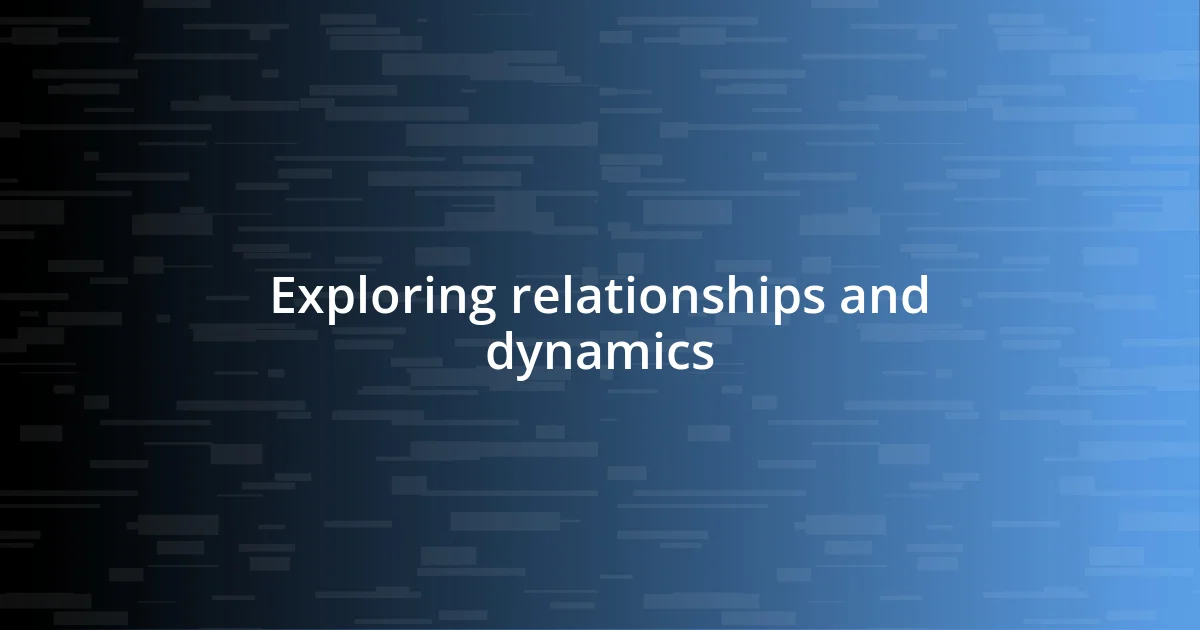
Exploring relationships and dynamics
Exploring relationships between characters reveals so much about their development. In “Pride and Prejudice,” the dynamic between Elizabeth Bennet and Mr. Darcy evolves dramatically, reflecting their shifting perspectives and underlying prejudices. I remember the moment when I realized that their misunderstandings were rooted in their failures to truly see each other. It made me think about how my own relationships have often been influenced by assumptions and miscommunication.
The power of secondary relationships also shouldn’t be overlooked. In “Wuthering Heights,” the toxic connection between Heathcliff and Catherine Earnshaw serves as a catalyst for their tragic fate, showcasing how love can morph into obsession. When I first read their story, I felt a mix of fascination and sadness. It reminded me of moments in my life where I witnessed friends lose themselves in all-consuming relationships, pushing the understanding of personal boundaries further out of reach.
Additionally, the contrast in relationships can heighten our understanding of a character’s values. Consider the friendship between Sam and Frodo in “The Lord of the Rings.” Their loyalty to one another beautifully illustrates the impact of support during adversity. Reflecting on such friendships in my own life has helped me appreciate the kind of unconditional support that truly nurtures growth. Isn’t it intriguing how character dynamics can mirror our experiences, helping us recognize the significance of human connection in our journeys?
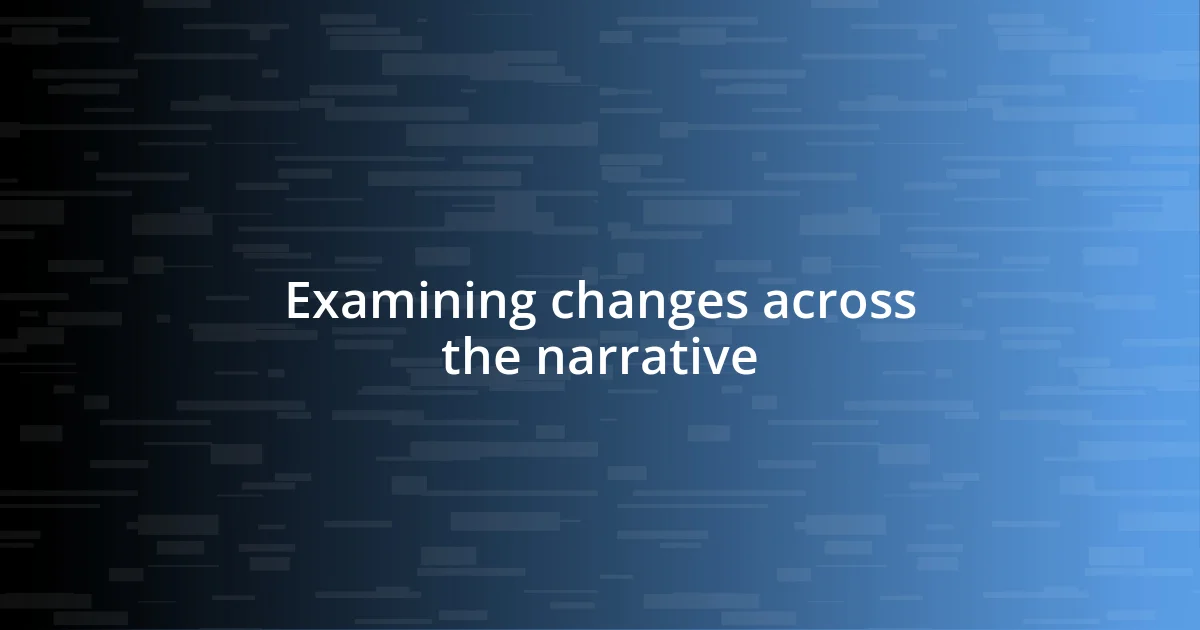
Examining changes across the narrative
When I observe changes across a narrative, I often look for pivotal moments that serve as turning points for characters. For instance, in “The Great Gatsby,” Gatsby’s gradual realization that his dream of rekindling the past with Daisy is unattainable hits hard. It resonates deeply with my own experiences of longing for something that may never return, reminding me how crucial it is to accept reality as it is.
Characters frequently evolve as they face challenges, and I’ve noticed that their responses to these trials reveal a lot about their growth. Take Jane Eyre: her resilience amid hardship teaches us about finding one’s voice in a world that often tries to silence us. Thinking back, there were moments in my life where I chose to stand my ground, just as Jane does, reflecting on how each choice carves a path of transformation.
Additionally, I find the impact of time on character progression to be fascinating. In “A Tale of Two Cities,” the shift in Sydney Carton from a dissolute figure to a self-sacrificial hero is striking. This change prompted me to ponder the concept of redemption. Aren’t we all capable of change, shaped by our experiences and the choices we make? Exploring these transformations in classics allows me to connect with their stories on a more personal level, igniting a sense of hope for the potential within us all.
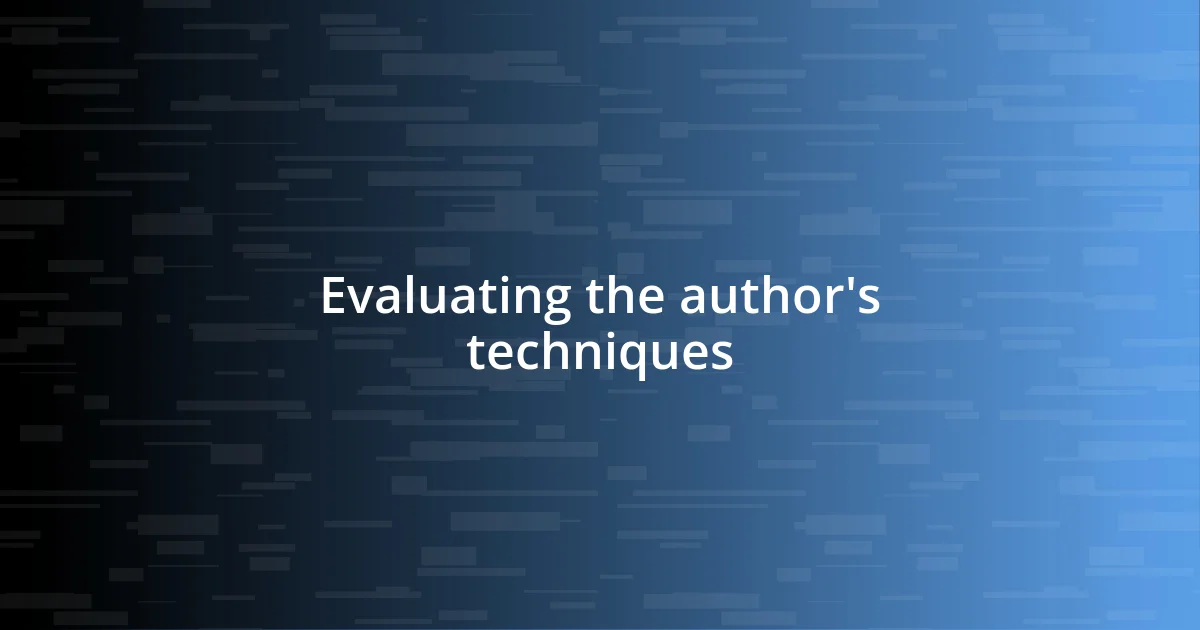
Evaluating the author’s techniques
To evaluate an author’s techniques, I pay close attention to how they employ literary devices to shape character development. For example, in “To Kill a Mockingbird,” Harper Lee’s use of imagery and symbolism—particularly through the mockingbird itself—underscores the innocence of characters like Boo Radley and Tom Robinson. I remember the moment I connected the symbolism of the mockingbird to my own life, reflecting on the importance of protecting the vulnerable.
Furthermore, the dialogue in a classic often reveals more than just words; it can serve as a window into a character’s soul. When I read “The Catcher in the Rye,” Holden Caulfield’s sardonic remarks and deep vulnerabilities resonated with my adolescent struggles. His raw, often jaded perspective made me evaluate the emotionally charged conversations I’ve had in my life—they resonate long after the words are spoken, don’t they?
I also notice how an author’s narrative structure can amplify character growth. In “One Hundred Years of Solitude,” Gabriel Garcia Marquez employs a nonlinear timeline, which evokes a sense of inevitability in the Buendía family’s fate. This technique forces me to consider how our past often haunts us, a realization that echoes in my own understanding of history and legacy. How often do we find ourselves trapped by our own histories, unable to break free?
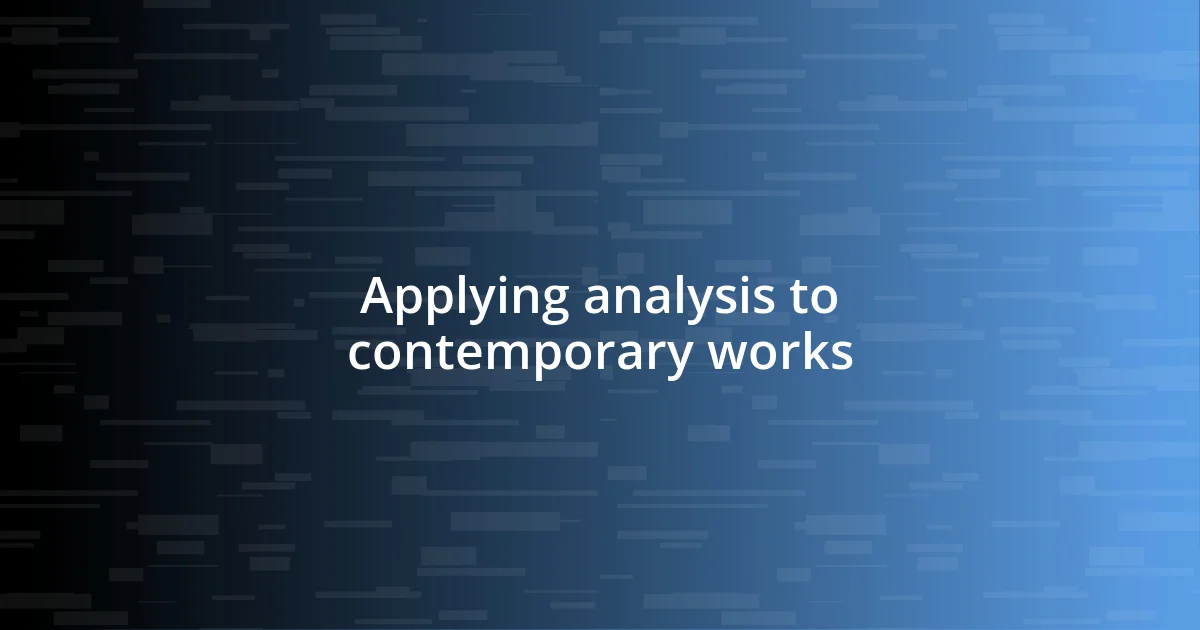
Applying analysis to contemporary works
When applying character analysis to contemporary works, I notice how modern authors often mirror the complexities found in classic literature. For instance, in “The Fault in Our Stars” by John Green, Hazel Grace Lancaster’s struggle with illness and her evolving relationship with Augustus Waters reflect emotional depth that’s reminiscent of classic tragic heroes. I still remember the lump in my throat during the climax, realizing that love and pain often exist hand-in-hand. Have you ever felt that rawness of emotion when reading a book that captures your experience?
Contemporary narratives frequently employ character arcs that emphasize self-discovery, much like in classics. In “Little Fires Everywhere” by Celeste Ng, Mia’s journey explores themes of motherhood and identity against societal expectations. This resonates with my own experiences as I’ve grappled between societal roles and personal aspirations. It made me ponder—how do our identities evolve when faced with external pressures that conflict with our inner truths?
Moreover, the use of diverse perspectives in modern storytelling adds another layer to character analysis that I find captivating. In “The Hate U Give,” Angie Thomas employs Starr’s voice to navigate issues of race and social justice, paralleling the rich character voices in classics like “The Color Purple.” I often find myself questioning what it means to stand up for what’s right, and how one’s environment shapes that journey. Isn’t it remarkable how character development across genres can illuminate our collective struggles and triumphs?




